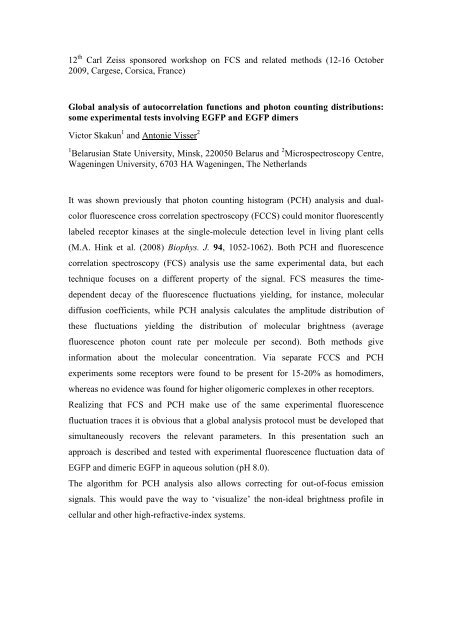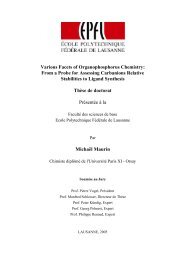12th Carl Zeiss sponsored workshop on ... - Institut Fresnel
12th Carl Zeiss sponsored workshop on ... - Institut Fresnel
12th Carl Zeiss sponsored workshop on ... - Institut Fresnel
You also want an ePaper? Increase the reach of your titles
YUMPU automatically turns print PDFs into web optimized ePapers that Google loves.
12 th <str<strong>on</strong>g>Carl</str<strong>on</strong>g> <str<strong>on</strong>g>Zeiss</str<strong>on</strong>g> <str<strong>on</strong>g>sp<strong>on</strong>sored</str<strong>on</strong>g> <str<strong>on</strong>g>workshop</str<strong>on</strong>g> <strong>on</strong> FCS and related methods (12-16 October<br />
2009, Cargese, Corsica, France)<br />
Global analysis of autocorrelati<strong>on</strong> functi<strong>on</strong>s and phot<strong>on</strong> counting distributi<strong>on</strong>s:<br />
some experimental tests involving EGFP and EGFP dimers<br />
Victor Skakun 1 and Ant<strong>on</strong>ie Visser 2<br />
1 Belarusian State University, Minsk, 220050 Belarus and 2 Microspectroscopy Centre,<br />
Wageningen University, 6703 HA Wageningen, The Netherlands<br />
It was shown previously that phot<strong>on</strong> counting histogram (PCH) analysis and dual-<br />
color fluorescence cross correlati<strong>on</strong> spectroscopy (FCCS) could m<strong>on</strong>itor fluorescently<br />
labeled receptor kinases at the single-molecule detecti<strong>on</strong> level in living plant cells<br />
(M.A. Hink et al. (2008) Biophys. J. 94, 1052-1062). Both PCH and fluorescence<br />
correlati<strong>on</strong> spectroscopy (FCS) analysis use the same experimental data, but each<br />
technique focuses <strong>on</strong> a different property of the signal. FCS measures the time-<br />
dependent decay of the fluorescence fluctuati<strong>on</strong>s yielding, for instance, molecular<br />
diffusi<strong>on</strong> coefficients, while PCH analysis calculates the amplitude distributi<strong>on</strong> of<br />
these fluctuati<strong>on</strong>s yielding the distributi<strong>on</strong> of molecular brightness (average<br />
fluorescence phot<strong>on</strong> count rate per molecule per sec<strong>on</strong>d). Both methods give<br />
informati<strong>on</strong> about the molecular c<strong>on</strong>centrati<strong>on</strong>. Via separate FCCS and PCH<br />
experiments some receptors were found to be present for 15-20% as homodimers,<br />
whereas no evidence was found for higher oligomeric complexes in other receptors.<br />
Realizing that FCS and PCH make use of the same experimental fluorescence<br />
fluctuati<strong>on</strong> traces it is obvious that a global analysis protocol must be developed that<br />
simultaneously recovers the relevant parameters. In this presentati<strong>on</strong> such an<br />
approach is described and tested with experimental fluorescence fluctuati<strong>on</strong> data of<br />
EGFP and dimeric EGFP in aqueous soluti<strong>on</strong> (pH 8.0).<br />
The algorithm for PCH analysis also allows correcting for out-of-focus emissi<strong>on</strong><br />
signals. This would pave the way to ‘visualize’ the n<strong>on</strong>-ideal brightness profile in<br />
cellular and other high-refractive-index systems.













